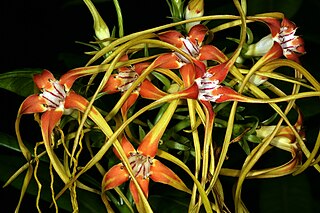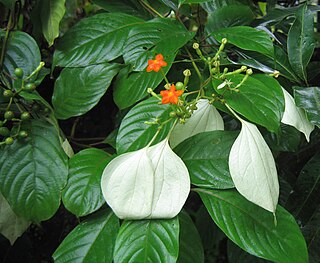
Apocynaceae is a family of flowering plants that includes trees, shrubs, herbs, stem succulents, and vines, commonly known as the dogbane family, because some taxa were used as dog poison. Members of the family are native to the European, Asian, African, Australian, and American tropics or subtropics, with some temperate members. The former family Asclepiadaceae is considered a subfamily of Apocynaceae and contains 348 genera. A list of Apocynaceae genera may be found here.

Elaeocarpus is a genus of nearly five hundred species of flowering plants in the family Elaeocarpaceae native to the Western Indian Ocean, Tropical and Subtropical Asia, and the Pacific. Plants in the genus Elaeocarpus are trees or shrubs with simple leaves, flowers with four or five petals usually, and usually blue fruit.

Strophanthus is a genus of flowering plants in the family Apocynaceae, first described as a genus in 1802. It is native primarily to tropical Africa, extending to South Africa, with a few species in Asia from southern India to New Guinea and southern China. The genus name is a compound of the Greek words στροφος (strophos) "twisted" and ανθοσ (anthos) "flower", in reference to the corolla lobes which, in some species - notably S. petersianus - resemble long twisted ribbons or threads and can reach a length of 30–35 cm. This trait, in addition to colouring involving combinations of bright pinks, purples and oranges, combine to make the flowers among the most ornamental in the plant kingdom.

Robert Wight MD FRS FLS was a Scottish surgeon in the East India Company, whose professional career was spent entirely in southern India, where his greatest achievements were in botany – as an economic botanist and leading taxonomist in south India. He contributed to the introduction of American cotton. As a taxonomist he described 110 new genera and 1267 new species of flowering plants. He employed Indian botanical artists to illustrate many plants collected by himself and Indian collectors he trained. Some of these illustrations were published by William Hooker in Britain, but from 1838 he published a series of illustrated works in Madras including the uncoloured, six-volume Icones Plantarum Indiae Orientalis (1838–53) and two hand-coloured, two-volume works, the Illustrations of Indian Botany (1838–50) and Spicilegium Neilgherrense (1845–51). By the time he retired from India in 1853 he had published 2464 illustrations of Indian plants. The standard author abbreviation Wight is used to indicate this person as the author when citing a botanical name.

Pergularia is a genus of the botanical family Apocynaceae. Pergularia daemia is a perennial twinning herb that grows along the roadsides of India and tropical and subtropical regions in South Asia, Africa, and Australia.

Millettia is a genus of flowering plants in the family Fabaceae. It consists of about 169 species of shrubs, lianas or trees, which are native to tropical and subtropical regions of sub-Saharan Africa, the Indian subcontinent, Indochina, southern China, Malesia, and New Guinea. Typical habitats include tropical rain forest and seasonally-dry lowland and upland forest and forest margins, woodland, thicket, wooded grassland, and secondary vegetation.
Goniostemma is a genus of plant in family Apocynaceae, first described as a genus in 1834. It contains two known species, one native to China, the other to India and Bangladesh.
- Goniostemma acuminataWight - India, Bangladesh
- Goniostemma punctatumTsiang & P.T. Li - Yunnan

Kibatalia is a genus of trees and shrubs in the family Apocynaceae, tribe Malouetieae, first described as a genus in 1826. It was initially called Hasseltia, but this turned out to be an illegitimate homonym. So Kibatalia was chosen as a replacement name. Kibatalia is native to China and Southeast Asia.
- Kibatalia arborea(Blume) G.Don – Thailand, Philippines, W Malaysia, Borneo, Sumatra, Java, Sulawesi
- Kibatalia blancoi(Rolfe ex Stapf) Merr. – Philippines
- Kibatalia borneensis(Stapf) Merr. – Sarawak
- Kibatalia elmeriWoodson – Luzon
- Kibatalia gitingensis(Elmer) Woodson – Philippines
- Kibatalia laurifolia(Ridl.) Woodson – Vietnam, Cambodia, Thailand, W Malaysia
- Kibatalia longifoliaMerr. – Mindanao
- Kibatalia macgregori(Elmer) Woodson – Sibuyan
- Kibatalia macrophylla(Pierre ex Hua) Woodson – Yunnan, Indochina
- Kibatalia maingayi(Hook.f.) Woodson – Thailand, W Malaysia, Borneo, Sumatra, Mindanao
- Kibatalia merrillianaWoodson – Leyte, Samar
- Kibatalia puberulaMerr. – Samar in Philippines
- Kibatalia stenopetalaMerr. – Luzon, Dinagat, Mindanao
- Kibatalia villosaRudjiman – W Malaysia, Borneo
- Kibatalia wigmani(Koord.) Merr. – Sulawesi
- Kibatalia africana(Benth.) Merr. = Funtumia africana(Benth.) Stapf
- Kibatalia elastica(Preuss) Merr. = Funtumia elastica(Preuss) Stapf
- Kibatalia latifolia(Stapf) Merr. = Funtumia africana(Benth.) Stapf
- Kibatalia scheffieri(K.Schum.) Merr. = Funtumia africana(Benth.) Stapf
- Kibatalia zenkeri(K.Schum.) Merr. = Funtumia africana(Benth.) Stapf

Peristylus, sometimes commonly known as ogre orchids or bog orchids is a genus of flowering plants from the orchid family, Orchidaceae. It consists of over 100 known species found across much of eastern and southern Asia as well as in Australia and on many islands of the Indian and Pacific Oceans.

Periploca is a genus of plants in the family Apocynaceae, first described for modern science by Linnaeus in 1753. It is native to Europe, Asia, and Africa.
- Periploca aphyllaDecne. - Middle East from Sinai to Pakistan
- Periploca calophylla(Wight) Falc. - S China, Nepal, Bhutan, Assam, E Himalayas, Vietnam
- Periploca chevalieriBrowicz - Cape Verde Islands
- Periploca chrysanthaD.S. Yao, X.D. Chen & J.W. Ren - Gansu Province in China
- Periploca floribundaTsiang - Yunnan, Vietnam
- Periploca forrestiiSchltr. - Guangxi, Guizhou, Qinghai, Sichuan, Tibet, Yunnan, India, Kashmir, Myanmar, Nepal
- Periploca graecaL. - Mediterranean
- Periploca hydaspidisFalc. - Kashmir
- Periploca laevigataAiton - Canary Islands, Savage Islands
- Periploca linearifoliaQuart.-Dill. & A. Rich - Ethiopia
- Periploca nigrescensAfzel. - W Africa
- Periploca refractifoliaGilli - Tanzania
- Periploca sepiumBunge - widespread across much of China
- Periploca tsiangiiD. Fang & H.Z. Ling - Guangxi Province in China
- Periploca visciformis(Vatke) K. Schum. - Somalia

Mussaenda is a genus of flowering plants in the family Rubiaceae. They are native to the African and Asian tropics and subtropics. Several species are cultivated as ornamental plants.

Periplocoideae is a subfamily of the dogbane plant family, Apocynaceae. It was not divided into tribes as of 2014.

Cosmostigma is a genus of plants in the family Apocynaceae, first described as a genus in 1834. It is native to tropical and subtropical Asia.
- Cosmostigma cordatum(Poir.) M.R.Almeida - India, Sri Lanka
- Cosmostigma hainanenseTsiang - Hainan Province in China
- Cosmostigma philippinenseSchltr. - Philippines

Heterostemma is a genus of plants in the family Apocynaceae, first described in 1834. It is native to India, China, Taiwan, Southeast Asia, Australia, and certain islands in the Pacific.
Pentatropis is a genus of plants in the family Apocynaceae, first described as a genus in 1834. It is native to Africa and southern Asia.
Myriopteron is a species of plants in the family Apocynaceae first described as a genus in 1844. It contains only one known species, Myriopteron extensum, native to Southeast Asia, India, and southern China. It can be found in Bangladesh.













